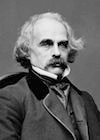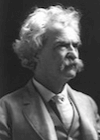New England Weather
by Mark Twain
New England Weather was anthologized in The Literary World Seventh Reader, John Calvin Metcalf, editor (1919). Twain's essay is accompanied by James Russell Lowell's The First Snowfall.
There is a sumptuous variety about the New England weather that compels the stranger’s admiration—and regret. The weather is always doing something there; always attending strictly to business; always getting up new designs and trying them on the people to see how they will go. But it gets through more business in spring than in any other season. In the spring I have counted one hundred and thirty-six different kinds of weather within four and twenty hours. It was I who made the fame and fortune of the man who had that marvelous collection of weather on exhibition at the Centennial, which so astounded the foreigners. He was going to travel around the world and get specimens from all climes. I said, “Don’t do it; just come to New England on a favorable spring day.” I told him what we could do in the way of style, variety, and quantity. Well, he came, and he made his collection in four days. As to variety, he confessed that he got hundreds of kinds of weather that he had never heard of before. And as to quantity, after he had picked out and discarded all that was blemished in any way, he not only had weather enough, but weather to spare, weather to hire out, weather to sell, weather to deposit, weather to invest, and weather to give to the poor.
Old Probabilities has a mighty reputation for accurate prophecy and thoroughly deserves it. You take up the paper and observe how crisply and confidently he checks off what to-day’s weather is going to be on the Pacific, down South, in the Middle States, in the Wisconsin region. See him sail along in the joy and pride of his power till he gets to New England, and then see his tail drop. He doesn’t know what the weather is going to be in New England. Well, he mulls over it, and by and by he gets out something like this: “Probable northeast to southwest winds, varying to the southward and westward and eastward and points between; high and low barometer, swapping around from place to place; probable areas of rain, snow, hail, and drought, succeeded or preceded by earthquakes with thunder and lightning.” Then he jots down this postscript from his wandering mind, to cover accidents: “But it is possible that the program may be wholly changed in the meantime.” Yes, one of the brightest gems in the New England weather is the dazzling uncertainty of it. There is certain to be plenty of weather, but you never can tell which end of the procession is going to move first.
But, after all, there are at least two or three things about that weather (or, if you please, the effects produced by it) which we residents would not like to part with. If we hadn’t our bewitching autumn foliage, we should still have to credit the weather with one feature which compensates for all its bullying vagaries—the ice storm. Every bough and twig is strung with ice beads, frozen dewdrops, and the whole tree sparkles cold and white like the Shah of Persia’s diamond plume. Then the wind waves the branches, and the sun comes out and turns all those myriads of beads and drops to prisms that glow and burn and flash with all manner of colored fires; which change and change again, with inconceivable rapidity, from blue to red, from red to green, and green to gold. The tree becomes a spraying fountain, a very explosion of dazzling jewels, and it stands there the acme, the climax, the supremest possibility in art or nature, of bewildering, intoxicating, intolerable magnificence. One cannot make the words too strong. Month after month I lay up hate and grudge against the New England weather; but when the ice storm comes at last I say: “There, I forgive you now; you are the most enchanting weather in the world.”
Return to the Mark Twain Home Page, or . . . Read the next essay; Niagara









